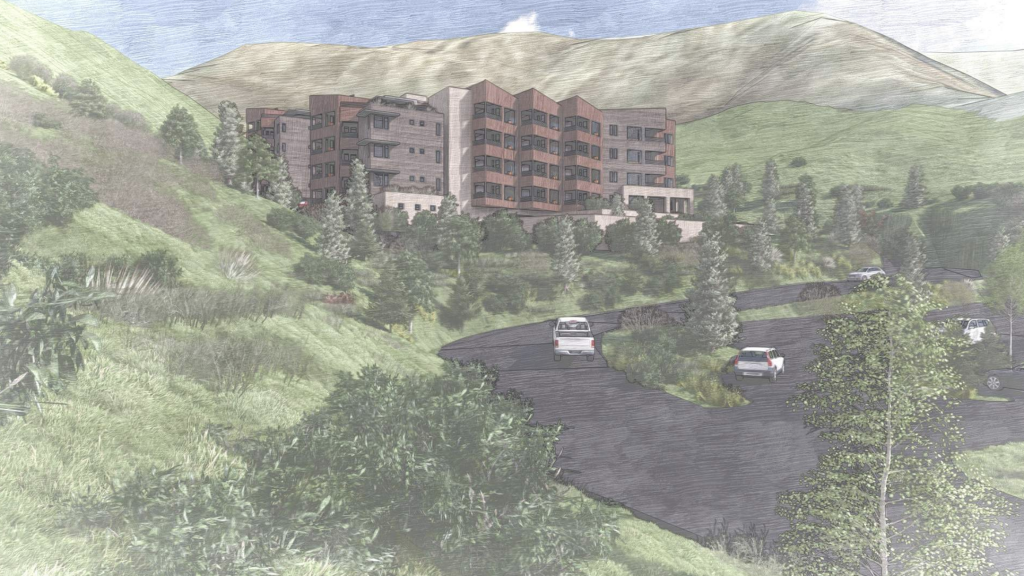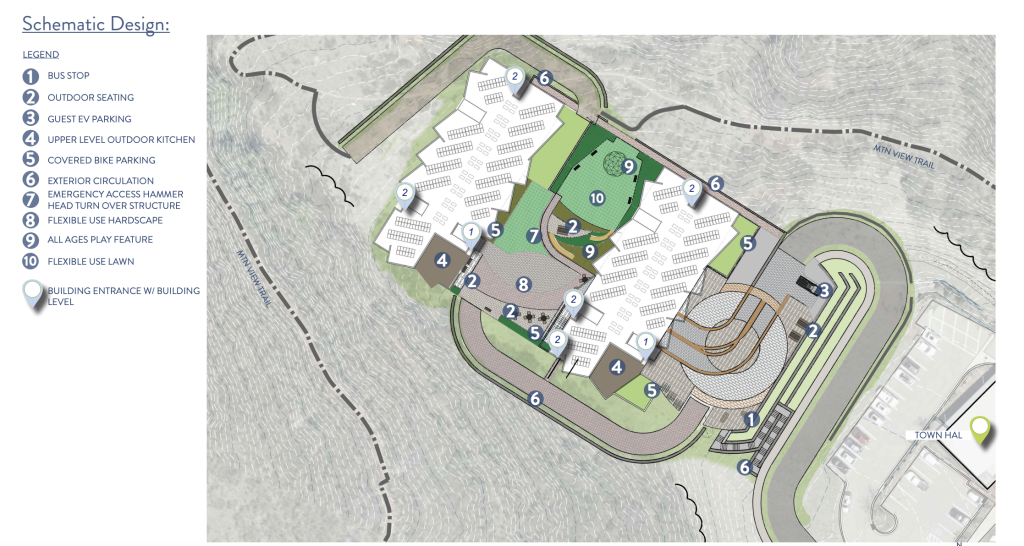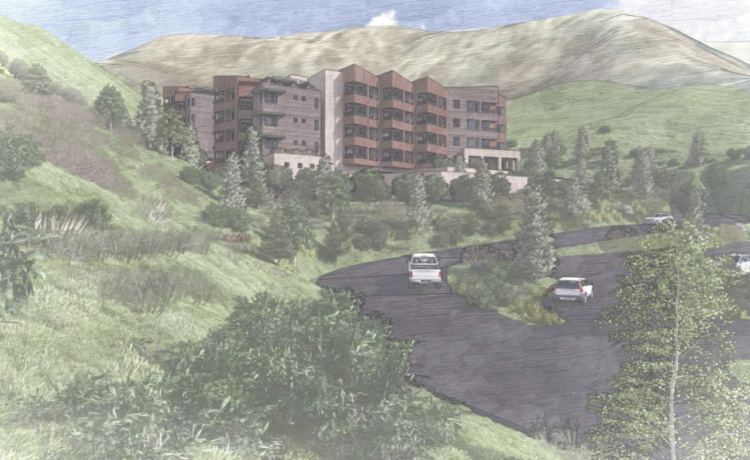
Site Architects/Courtesy Image
After reviewing the most recent financial analysis for an $86 million affordable housing project, Snowmass Village financial advisory board members maintained that the town had the money to finance it, but cautioned that it could hamstring future developments.
The $86 million, 79-unit Draw Site project will go before voters in November. The town is asking voters whether they approve of it using tax revenues, state grants, rental incomes, and more to build its largest workforce housing rental development in 25 years. The advisory board said the funding sources for the Draw Site were accurate, but the town should consider the implications of having to pay off the project for the next 30 years.
“Our concern is this is very expensive,” said advisory board representative Phil Sirianni during a Snowmass Town Council meeting Monday. “This is supposed to be affordable housing units, but this project is about $1 million per unit, so that’s what you guys need to think about.”
Growing construction costs have contributed to the $86 million price tag of the development. About $70 million will come from bond financing, an estimated $10 million will come from state and other local government grants, and about $5.4 million will come from partnering with local businesses to sell housing priorities or units for local businesses to subsidize for their employees. The town will owe about $3 million annually to finance the bond, according to the advisory board’s review.
The town plans to use a portion of its tourism tax revenue to fund the remaining $3 million annual cost. In 2022, voters approved allocating a portion of the tourism tax fund toward workforce housing projects. According to current tourism tax revenue, $3 million would take up 60% of the funds earmarked for housing, potentially hindering any future housing projects the town wants to use these funds for, Sirianni said.
With this in mind, the advisory board recommended amending the town’s 2021 housing master plan, which set a goal of building 200 affordable housing units to address the growing affordable housing crisis in the village.
“Your guys’ goal is to get 200 units. If you’re spending $3 million alone from that $5 (million) to $5.5 million (from the tourism tax fund), you’re not getting the 200 units,” Sirianni said. “You’ll run out of money if you’re planning for 200 units, unless you go look somewhere else (for funding).”
The tourism tax fund isn’t the only option for the town to finance future workforce housing projects, but it is one of the only funds consistently available specifically for workforce housing. The town could pursue local, state, and federal funds to finance future projects — like it is doing for the Draw Site — and several state agencies have indicated interest in funding affordable housing projects in the mountains, Snowmass Housing Director Betsy Crum said.
But with the town in negotiations to purchase three acres of land next door to the Draw Site behind the Snowmass Center to build workforce housing, it could spend a majority of the tourism tax funds on those two projects for several years to come, Sirianni said.

The advisory board cited the opportunity cost of building the 79 Draw Site units, and recommended considering building projects downvalley or in more suitable sites, like near the Brush Creek Road intercept lot.
“Do you have the money to do this now? Yes, you do. But you are limiting yourselves to things you could do in the future because just the cost of doing this,” Sirianni said. “Think of the opportunity cost of doing this project versus doing downvalley projects … I know the town wants to have housing up here in Snowmass, but the problem is you’re limited here to where you can build.”
For months, Snowmass Town Council members have discussed the mass and scale of the Draw Site project as it has gone through a lengthy planned unit development (PUD) process. Some council members have said the project as it currently exists — a two-tower design with 79 units and underground parking on a steep plot of land northwest of Town Hall — is too much for the site and should be downsized.
Councilmember Tom Fridstein has consistently urged town staff to downsize the project and remove the underground parking, which he and Sirianni said is a big portion of the cost.
“It’s a lot of indebtedness and maybe we should be saving our money for where it’ll really have an impact,” Fridstsein said. “I mean, when we started the Draw Site, the Center site was not a possibility, no one was thinking about that, and maybe we should be reconsidering how much we build on the Draw Site.”
The cost-per-unit for the Draw Site is about $1 million. To downsize the project, the town would likely need to raise rents, potentially making the units unaffordable for the town’s workforce, Crum has said in the past.
The town is also exploring housing options outside of Snowmass. During the Monday meeting, it approved the purchase of two priorities for a condominium complex in Glenwood Springs that Habitat For Humanity is facilitating. But organizations and municipalities throughout the Roaring Fork Valley are all vying for space to build workforce housing, and some council members said the town should jump on opportunities as they arise, especially if it means keeping the Snowmass workforce in the village.
“I would say that housing people in our village and building community is another consideration, not just the economics of the project, and I think about what needs to happen for a community to be sustainable and still be viable,” said Councilmember Susan Marolt. “If you have a place where young people or young professionals or people in the earlier stages of their careers can’t find housing, then they don’t establish a community here. Then pretty soon, you don’t have people who are building businesses and who are moving up in the hierarchy of the economy that we need in our town.”
Sirianni stressed the importance of the 30-year financial commitment to the project, and encouraged the town to think of the most economical way to approach it.
Councilmember Britta Gustafson said that while she doesn’t disagree with building community, she is concerned about high costs affecting future housing opportunities.
“This problem’s not going to be solved a decade from now, but we’re going to be paying for it for 30 years, so I hear both sides of these concerns,” she said. “And it’s certainly nice to have people living here, but if the workforce employment need is more dire than building a community right now, I mean I think there are conversations to be had as well.”
Gustafson has also encouraged town staff to consider downsizing the project during several Draw Site presentations.
Voters will be asked to authorize the town spending up to $86 million on the Draw Site project, which will have a mix of up to 79 one-, two- and three-bedroom units. While approving the final ballot language for the Draw Site on Monday, the town council agreed to use the term “up to” to allow for flexibility if the project is downsized in the future. Voter approval would not obligate the town to build the project if extenuating circumstances arise during the development process.
The town will formally approve the ballot language during its Sept. 3 town council meeting. Council members are seeking community input on the project and encourage people to make public comments at the Sept. 3 meeting.















